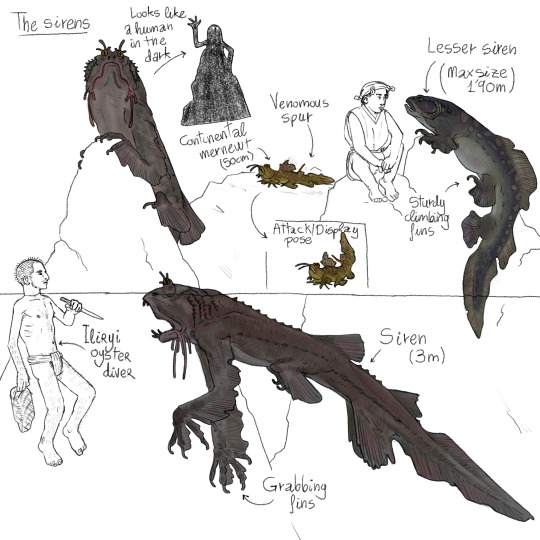#enconters in the Frontier
Explore tagged Tumblr posts
Text

Sirens of Encounters in the Frontier.
In my setting, sirens are a kind of shark, descendants of a creature most similar to an epaulette shark, wich adapted to hunt fish and mollusks trapped during the low tide and eventually evolved to be fully lunged and mostly amphibian.
There are 3 species of sirens, all 6 limbed.
-The continental mernewt is native to the vast beaches and coral reefs of the southeastern coast of the continent. It's similar in bodyplan to a mudskipper and just as agile. They have jaws strong enough to open shellfish and don a venomous spur next to their tail fin, wich can kill small animals and cause pain, swelling and even necrosis of the limbs in larger animals like humans.
Male mernewts are known to "fence" each other as they are very territorial during mating season. This fights envolve leaps into the air, stabbing with their spurs, biting and their characteristic shriek.
These animals are very important in the culture of the warrior caste in the Sun Empire and represent masculine violence and war, sometimes positively (they are kept in artificial ponds ocasionally) or as a critique in poetry of the futility of war, since the mernewts are vulnerable to birds of prey or other predators while exhausted after a fight.
-The lesser siren is the most terrestrial of all sirens. Its native to the eastern and southern coast of the continent, the north of alwaysummer and the Twisted Islands.
These creatures feed mostly on fish stranded during low tides but many hunt seabirds by staying still between rocks in the shore until the perfect ocasion to leap and catch its prey with their clawed pectoral fins. They usually drag their prey to the water and drown it there. They are very capable of climbing rocks and can be quite fast in short bursts of speed.
They can get quite large and pose a significant danger to some cattle and humans.
-Sirens are native to the Twisted Islands and are the most aquatic of the three, even though they can still return to the sea if they get stranded.
They spend most of the day in underwater caves and are actually quite good at hunting in the sea floor, as they use their long arm like pectoral fins to move rocks and expose mollusks and other small prey. Still, their prey of choice are terrestrial animals. Sirens are indeed quite intelligent animals, though far from sapient, as they resemble the intelect of a marine crocodile, wich manifests in very specialiced hunting tactics.
They have learned to attract land animals close enough to the water by leaving small pieces of fish in the shore as bait for seabirds or imitating animal cries for help to attract unsuspecting predators or worried members of the imitated species. When they get the chance, they rapidly extend their arm-like fins and drag the animal to the sea.
Some sirens have specialiced in hunting humans, specially those on boats, wich is a big problem given how common reed boats and low canoes are for transport in the twisted islands, often used to also transport cattle.
Sirens can easily climb on top of these boats or colaborate between many to topple a ship.
They don't hunt in organized groups, rather they all hunt individually but at the same time, if that makes sense, and later fight for the prey.
These human eating sirens have learn to stand on small islands or unlit shores ar night and waive their arm-like fins while screaming (they can imitate a great variety of sounds) to lure humans closer to them.
The Iliryi people (those native of the twisted islands) have developed many methods to sail safely, such as covering their boats with down facing spikes, tying themselves to the boat or just carrying harpoons and being ready for action. Still, these tactics are not very efective when overwhelmed by a large group of sirens.
The government of the twisted islands hires whalers and fishermen from all across the eastern sea during their low season to work as sirens hunters, wich escort other ships and keep the siren population at bay. This is a high risk high reward job for these fishermen.
#fantasy worldbuilding#spec evo#worldbuilding#creature design#fantasy art#spec bio#art#concept art#fantasy#siren#mermaid#merman#mermen#enconters in the Frontier#my art#my artwork#original species#original art#twisted islands
1K notes
·
View notes